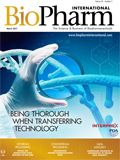Covering Global Regulations in a Quality System
Siegfried Schmitt, PhD, Principal Consultant at PAREXEL, discusses how to mitigate risk in a global regulatory environment.
Q: During a recent inspection by the Chinese regulatory authority, we were informed that our quality system had not met all requirements of Chinese good manufacturing practices (GMP). We export to many countries around the world and regulatory compliance is of the utmost importance. Could you advise on how to mitigate future regulatory risk?
A: It is important to understand the nuances of each regulatory authority and take the appropriate steps to fully abide by each set of standards. Some agencies wish to see their regulations specifically stated in a company’s quality system, whereas others are satisfied with a generic statement (e.g., “we comply with all applicable laws and regulations in the markets we operate in”) about compliance.
In addition to a generic statement, consider including a list of the regulations (e.g., 21 Code of Federal Regulations 210, 211, and 820; EudraLex Volume 4 Part II) in your quality manual or similar high-level document. It’s unclear if the inspectors felt your company had not clarified within the quality management system (QMS) which regulations it knowingly complied with. Including a list of regulations will help ensure transparency.
It is also unclear whether your company assured compliance with all the country’s regulations and provided documented evidence. Inspectors often prefer organizations demonstrate compliance through established processes and documented evidence. All too often, companies list within their standard operating procedures (SOPs) a series of regulations pertinent to the subject of the SOP (e.g., International Council for Harmonization [ICH] Q9 in a risk management SOP). Merely listing a regulation, however, doesn’t demonstrate that you have read, understood, and implemented it into your QMS. You must have a process in which dedicated persons or teams assess regulations for their applicability to your operations, and then implement these into your QMS. Documenting this process provides the necessary proof of compliance.
In your particular case, employees fluent in the Chinese language should review the regulations, log which regulations they reviewed for documentation purposes, and then implement the new or changed requirements from these regulations within the QMS as necessary. For example, if the cleaning SOP would require an amendment, this amendment should be noted in the change section of the document.
It is necessary to maintain compliance with current regulations; any regulatory changes must be assessed for their impact on your QMS. This assessment may require a review of all documents in your QMS, unless you maintain a matrix (e.g., in a spreadsheet or relational database) that shows which regulation translates into which documents (e.g., SOPs) within your QMS. Such a correlation matrix has another important benefit: should you plan a change to a system, process, or document, you could easily verify if this is permissible under the regulations impacted by the change.
It is unlikely that such a matrix is 100% complete, covering all and every regulation from every country you operate in. However, taking a detail-oriented, risk-based approach helps ensure you cover the countries and regulations most critical to your operations.
Article Details
BioPharm International
Vol. 30, No. 3
March 2017
Page 58
Citation
When referring to this article, please cite it as S. Schmitt, "Covering Global Regulations in a Quality System," BioPharm International 30 (3) 2017.

MHRA Approves GSK Therapy Combinations for Multiple Myeloma
April 21st 2025Belantamab mafodotin is approved in combination with bortezomib plus dexamethasone in patients who have had at least one prior therapy, and in combination with pomalidomide plus dexamethasone for those who have had a prior therapy including lenalidomide.